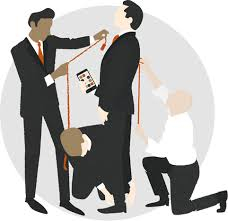 We often hear the customer is always right!, but is this really true? Haven’t we all been in situations where the customer is asking for something unreasonable or is simply downright wrong? Aren’t there times when the customer is dead wrong?
We often hear the customer is always right!, but is this really true? Haven’t we all been in situations where the customer is asking for something unreasonable or is simply downright wrong? Aren’t there times when the customer is dead wrong?
This general strategy reflects the fact that 5:1 it is more expensive to acquire a new customer than to retain an existing one. So even when the customer is wrong, accommodating their idiosyncrasies is worth losing a battle to win the profit war because acquiring customers is so expensive.
Today we take a more nuanced position.
If the customer is unreasonable and unprofitable then it makes no sense to adopt the motto that the customer is always right!. Unprofitable accounts are retained if they are strategic and either 1) become profitable, or 2) draw enough profitable accounts into the company to make up for the loss. This strategy is employed by start-ups to get their first customer.
 Recognizing bad customers is usually not difficult. Transactional customers are often bad customers; especially those that want the lowest price and act as though every product is a commodity; they try to play vendors off against each other despite quality requirements.
Recognizing bad customers is usually not difficult. Transactional customers are often bad customers; especially those that want the lowest price and act as though every product is a commodity; they try to play vendors off against each other despite quality requirements.
It is often useful to allow transactional customers interested in the lowest price to purchase from competitors on price and let the lack of a quality solution come back to haunt them. Reducing quality to meet customer price objectives will leave you with customer complaints when product and service quality is substandard.
 When sales executives chase all opportunities hoping for a sale is when transactional buyers are courted and you get pulled into pricing concessions from demanding customers. The problem is demanding transactional buyers won’t just ask for the best price, they will also ask for product changes.
When sales executives chase all opportunities hoping for a sale is when transactional buyers are courted and you get pulled into pricing concessions from demanding customers. The problem is demanding transactional buyers won’t just ask for the best price, they will also ask for product changes.
There is no doubt that customer requirements need to be a driver for product management it is an early indication of changing markets. But, accepting all customization requests is impossible and would cripple your product and brand.
Constant unreasonable requests leave internal resources believing that sales people have extremely low IQs and morals.
 Good sales people understand these principles and don’t chase bad customers. But, there are not enough good sales people to go around, so virtually every company has a less-than-excellent sales person making trouble for product management and engineering.
Good sales people understand these principles and don’t chase bad customers. But, there are not enough good sales people to go around, so virtually every company has a less-than-excellent sales person making trouble for product management and engineering.
To make matters worse, sales people are very good at making a case that all customers are strategic and argue that a short term loss will eventually turn into a long term gain. This behavior is normal and expected because sales is driven by commissions, which are often revenue based. Hopefully, your sales process is robust enough to catch these attempts which would saddle you with bad customers.
 If you find yourself in a position where you have acquired one or more bad customers (you know who they are..) then your best course of action is to find some way to send them to your competitors. This will increase your profitability and reduce the stress of unreasonable requests flooding into product management and engineering.
If you find yourself in a position where you have acquired one or more bad customers (you know who they are..) then your best course of action is to find some way to send them to your competitors. This will increase your profitability and reduce the stress of unreasonable requests flooding into product management and engineering.
The customer is not always right, but with due diligence and account reviews you can determine the customers that should be retained and those that should be let go.
 Don’t be afraid to let unprofitable and non-strategic customers go. You will feel less stressed and be better off in the long run.
Don’t be afraid to let unprofitable and non-strategic customers go. You will feel less stressed and be better off in the long run.



 Time pressures to make a sale put us under pressure and this stress leads to making quick decisions about whether a product or solution can be sold to a customer. We listen to the customer but interpret everything he says according to the products and solutions that we have.
Time pressures to make a sale put us under pressure and this stress leads to making quick decisions about whether a product or solution can be sold to a customer. We listen to the customer but interpret everything he says according to the products and solutions that we have. We hear the word car and we think that we know what the customer means. The order-taker sales person will spring into action and sell what he thinks the customer needs. Behind the word car is an implied usage and unless you can ferret out the meaning that the customer has in mind, you are unlikely to sell the correct solution.
We hear the word car and we think that we know what the customer means. The order-taker sales person will spring into action and sell what he thinks the customer needs. Behind the word car is an implied usage and unless you can ferret out the meaning that the customer has in mind, you are unlikely to sell the correct solution. Sometimes heroic actions by the product management, professional services, and software development teams lead to a successful implementation, but usually not until there has been severe pain at the customer and midnight oil burned in your company. You can eventually be successful but that customer will never buy from you again.
Sometimes heroic actions by the product management, professional services, and software development teams lead to a successful implementation, but usually not until there has been severe pain at the customer and midnight oil burned in your company. You can eventually be successful but that customer will never buy from you again. Selling the correct solution to the customer requires that you understand the customer’s problem before you sell the solution.
Selling the correct solution to the customer requires that you understand the customer’s problem before you sell the solution.